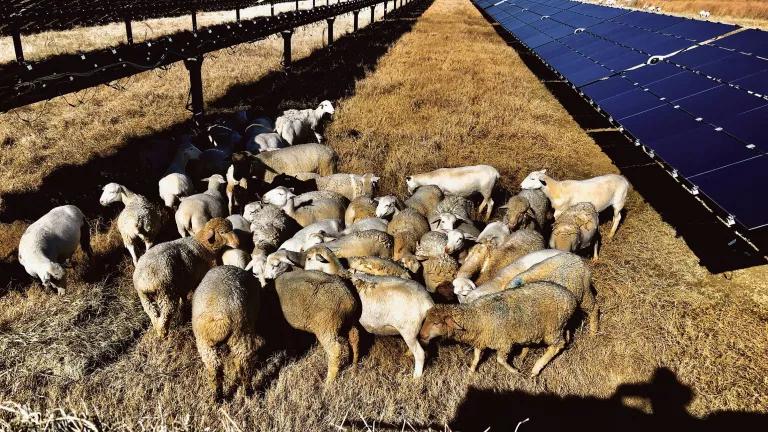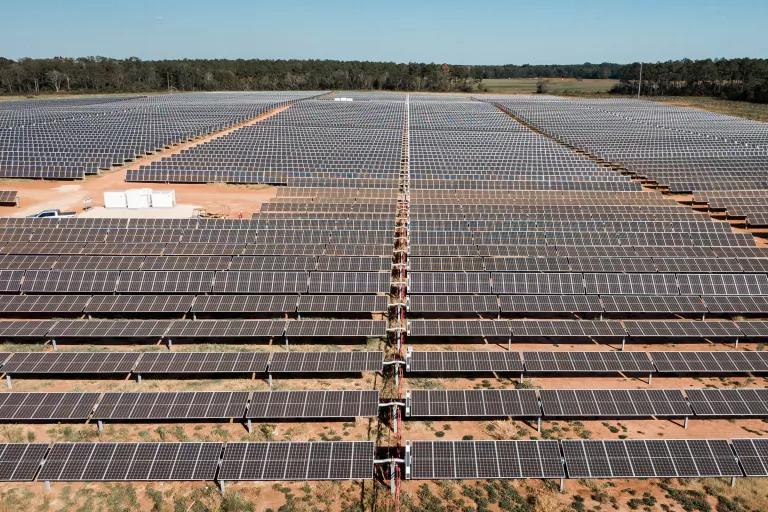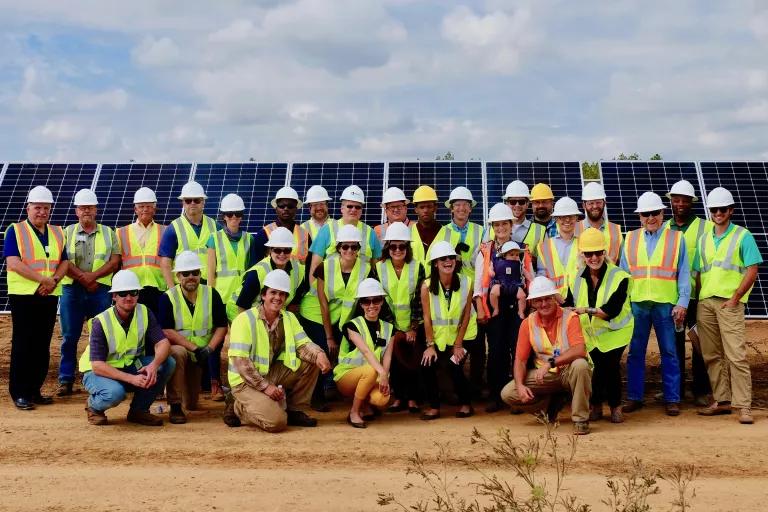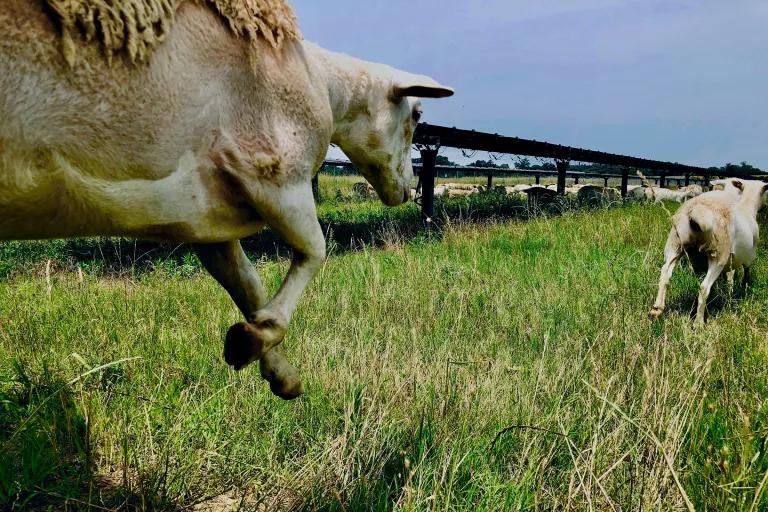Sheep (and Soil Scientists) Juice Up the Solar Farm
Solar farmers get a hand from regenerative agriculture experts to feed the soil under their arrays—another powerful tool to help fight climate change.

Sheep graze the land at Silicon Ranch’s Providence Solar Farm in Tennessee to restore soil, biodiversity, and agriculture.
This is a tale of two farms: White Oak Pastures and Bancroft Station Solar Farm. Both are located in rural southwestern Georgia, a region synonymous with agriculture (read: peanuts, corn, cotton, and cattle). Both harvest the bounty of nature. Yet White Oak Pastures is as old as Bancroft Station is new. The sixth-generation homestead operates as the economic and social hub for the town of Bluffton (population 100) and as a paragon of regenerative agriculture through its pasture-raised livestock and devotion to maintaining healthy soils and a balanced ecosystem. Bancroft Station, a state-of-the-art solar power facility, went online two months ago to power a huge Facebook data center and help meet the company’s 100 percent renewable energy goal.
On the face of it, the businesses couldn’t be farther apart. After all, the emphasis in the term “solar farm” falls prominently on the first word; the developments are just as often called “solar power stations” or “photovoltaic power plants.” But many are, in fact, built on former croplands. Indeed, cotton and peanuts previously grew on the 700 acres where Bancroft Station now sits, and cattle grazed there.
Some cotton plants still linger around the arrays, too—proof that a transition is taking place. And that’s a good thing, says William Harris III, herdsman and mastermind behind White Oak Pastures. He believes that solar developers should take a page from traditional, holistic farmers in caring for their land. So when he learned that thousands of acres of solar would rise in his community, he invited Reagan Farr, the CEO of solar farm developer Silicon Ranch, for a visit. He was wary at first, concerned that Farr would overmow his newly acquired turf and spray it with pesticides. “I didn’t expect to like him,” says Harris. “And we just hit a real accord.”
In a world where old and new school rarely see eye to eye, these two farms are joining forces to build a more sustainable future from the ground up. Come springtime, Harris will release 1,000 sheep among Bancroft Station’s more than 350,000 solar arrays to graze, nap in the panels’ shade, and naturally fertilize the soil. The low-tech lawn care arrangement (i.e., sheep rental) will yield a cascade of benefits for the land, from erosion prevention and flood control to improved carbon sequestration. In turn, the sheep will fatten up on the vegetation, making the business partnership doubly good for the rancher’s bottom line.
The farms’ alliance offers lessons to other developers of solar power, which is booming in the Southeast. The Southern Alliance for Clean Energy (SACE) projects that solar capacity will more than double across the region in the next couple of years. Many of the new projects are being driven by clean energy demands from tech giants and other Fortune 500 companies. In 2018, Facebook drove solar commitments in Georgia (totalling 203 megawatts), Alabama (227 MW), and Tennessee (150 MW). Google announced projects of 150 MW each for Tennessee and Alabama.
The sheep address a central upkeep challenge faced by solar developers like Silicon Ranch, which operates nine utility-scale projects in Georgia, Mississippi, and Tennessee. Left uncut, the vegetation growing beneath solar panels limits functionality and accessibility. However, conventional mowing, weed whacking, and using herbicides and pesticides “break the hell out of the natural cycles,” says Harris, leading to soil degradation, erosion, and chemical runoff that pollutes waterways.

Regenerative agriculture experts say sheep are the perfect animals for the job. They don’t climb (like goats), aren’t too big (like cows), and are not known for damaging solar equipment. And they take care of the pricey business of lawn care naturally and cost effectively. To be clear, replacing lawn mowers with sheep on solar farms is not new. Sheep have grazed solar farms across the United Kingdom since 2011, and California pioneered the practice in the United States, says Harris. Other states, including North Carolina, have followed suit. However, thanks to Harris’s experience and vision, Silicon Ranch is expanding the model to achieve goals well beyond grass trimming on the cheap.
“What makes us a little different is that this is not just solar plus sheep,” says Michael Baute, an expert on soil and crop sciences whom Farr hired as Silicon Ranch’s director of regenerative energy and land management after Harris introduced them at the initial meeting between the farms. “This is about regeneration and holistic management for the land.”
Silicon Ranch calls the combination of renewable electricity generation, ecosystem restoration, and food production “regenerative energy.” Ten of the company’s solar farms in Mississippi, Tennessee, Alabama, and Arkansas are already testing the model. Partnering with the right ranchers is key. Trent Hendricks, owner of the holistically managed Cabriejo Ranch and another friend of Harris, has been a good match for the company, transporting what he calls his “regenerative road show” of sheep from site to site.

“We’re really passionate about it and feel it’s one of the most important opportunities in food agriculture,” says Hendricks. “The animals improve, plants improve, and soils improve, and we just have this ecosystem that continues to flourish,” he adds, noting that the solar farm now attracts ground-nesting birds, rabbits, hawks, and eagles.
Claire O’Connor, director of NRDC’s water and agriculture program, sees this sort of holistic thinking around land stewardship as a critical development for the burgeoning solar industry. Healthy soil is the secret weapon in the fight against climate change, she says, and regenerative farming practices play a significant role in the sequestering of atmospheric carbon. Our planet’s three largest carbon sinks are its oceans, plants, and soils. And if we don’t take care of them properly, they turn from carbon sponges into carbon emitters.

“Over the last several decades we’ve run up a big soil carbon debt,” O’Connor says. “We can start to repay that debt by feeding the soil.” Among the tools we have to help protect the planet, she notes, “the soil carbon is a piece we haven’t paid as much attention to and offers a huge opportunity to help us stay below the most dangerous climate thresholds.”
White Oak Pastures proves the point, says Harris. According to a life cycle assessment study, the soil organic matter rose from 1 to 5 percent on the farm’s regeneratively managed fields over 20 years. Researchers also found the farm offsets as much as 85 percent of its total carbon emissions. “It is not a zero-sum game on this planet,” says Harris. “If all cycles and systems are working as planned, every year the earth grows richer.”
Both White Oak Pastures and Silicon Ranch hope to stimulate healing and reap the benefits. This is how the tale of two farms merge and strengthen.
“It’s a great symbiotic relationship,” says Harris. “Twenty years from now, Silicon Ranch’s land will have 5 percent organic matter and real economic value.” With its new method of vegetation control, “we’re all going to benefit because of the carbon sequestration,” he notes. And “the community wins because I’ll need to hire more people.”
This NRDC.org story is available for online republication by news media outlets or nonprofits under these conditions: The writer(s) must be credited with a byline; you must note prominently that the story was originally published by NRDC.org and link to the original; the story cannot be edited (beyond simple things such as grammar); you can’t resell the story in any form or grant republishing rights to other outlets; you can’t republish our material wholesale or automatically—you need to select stories individually; you can’t republish the photos or graphics on our site without specific permission; you should drop us a note to let us know when you’ve used one of our stories.

What’s the Most Energy-Efficient Water Heater?
How to Ditch the Biggest Fossil Fuel Offenders in Your Life
How You Can Stop Global Warming